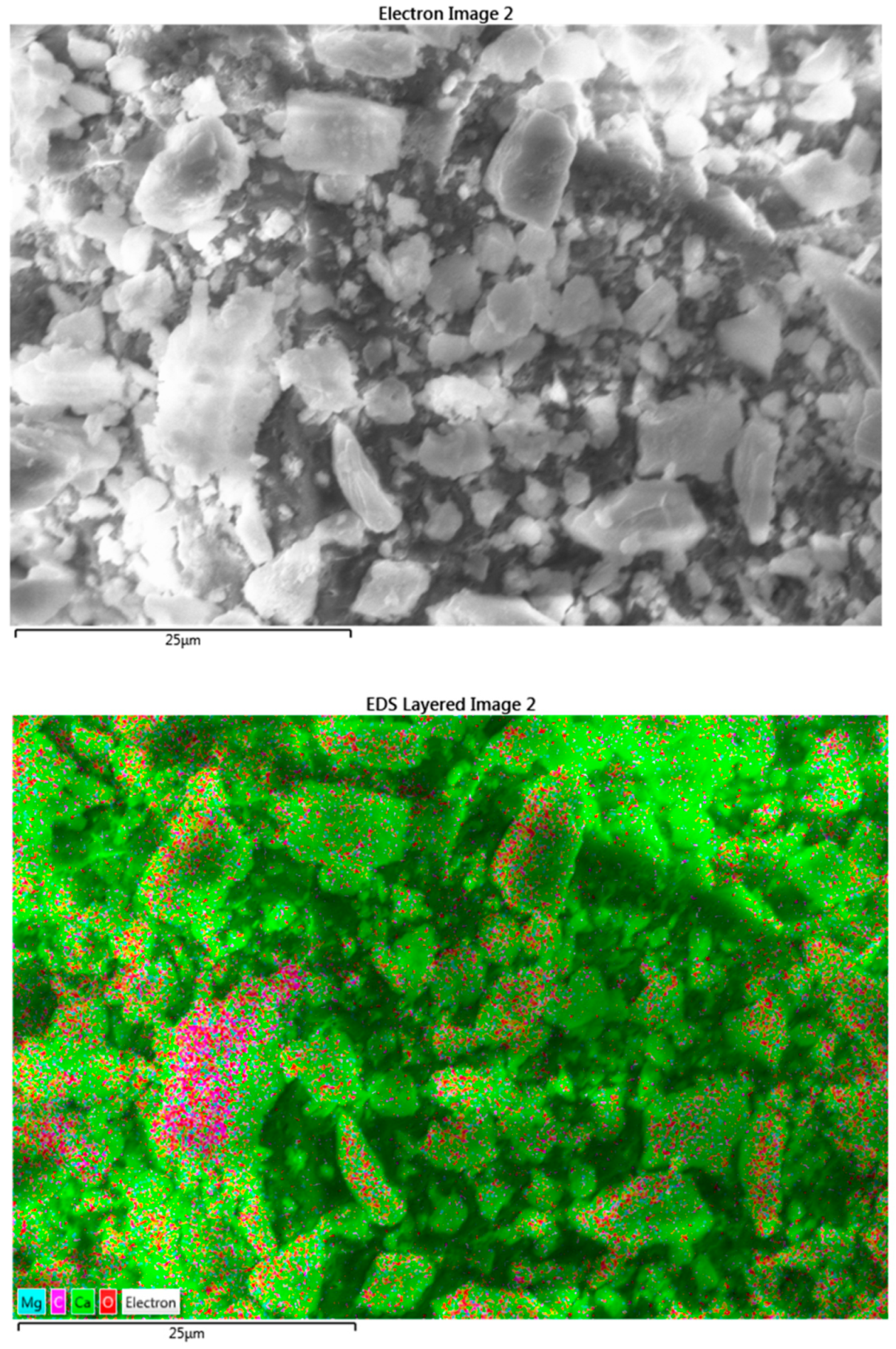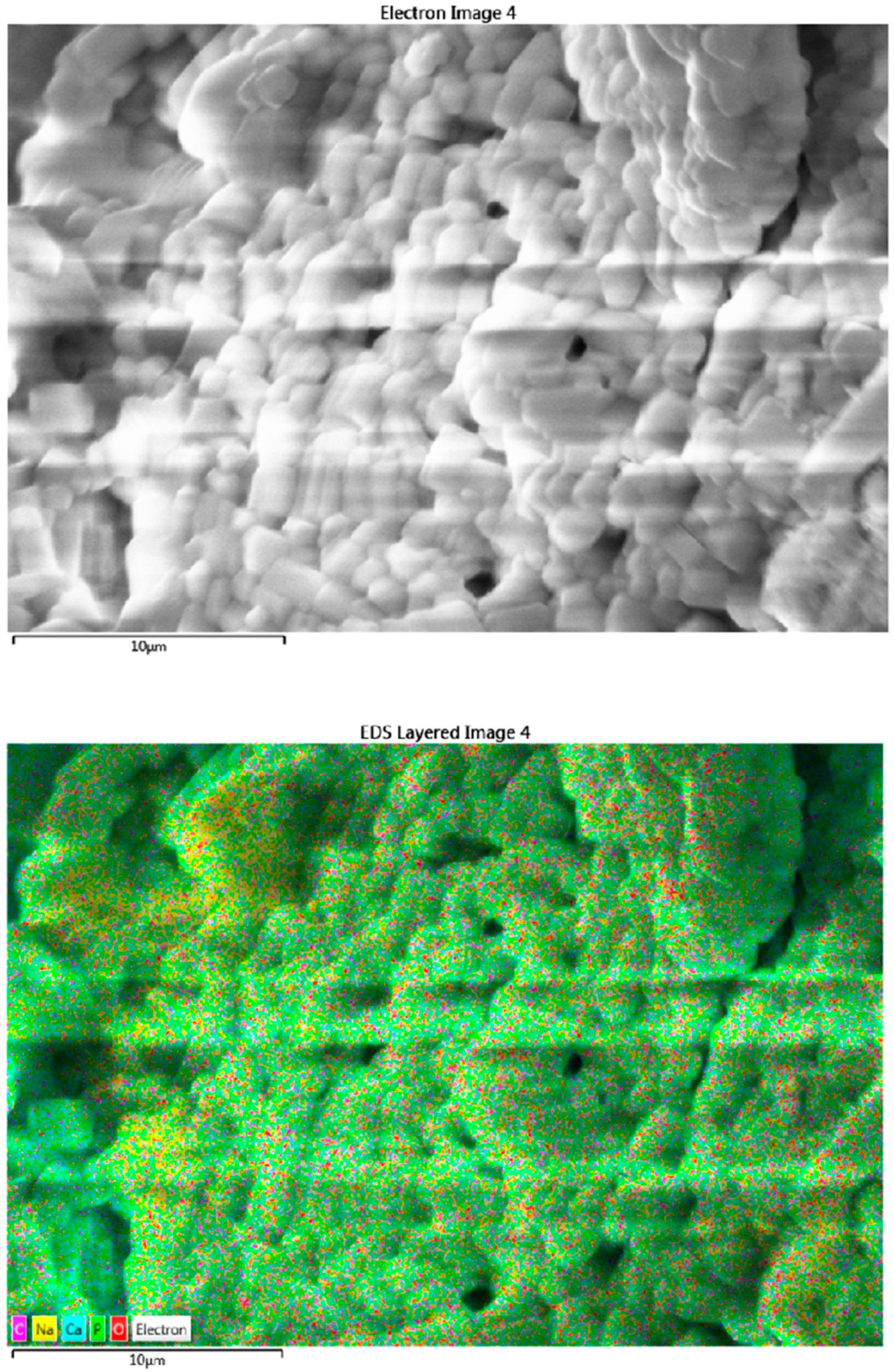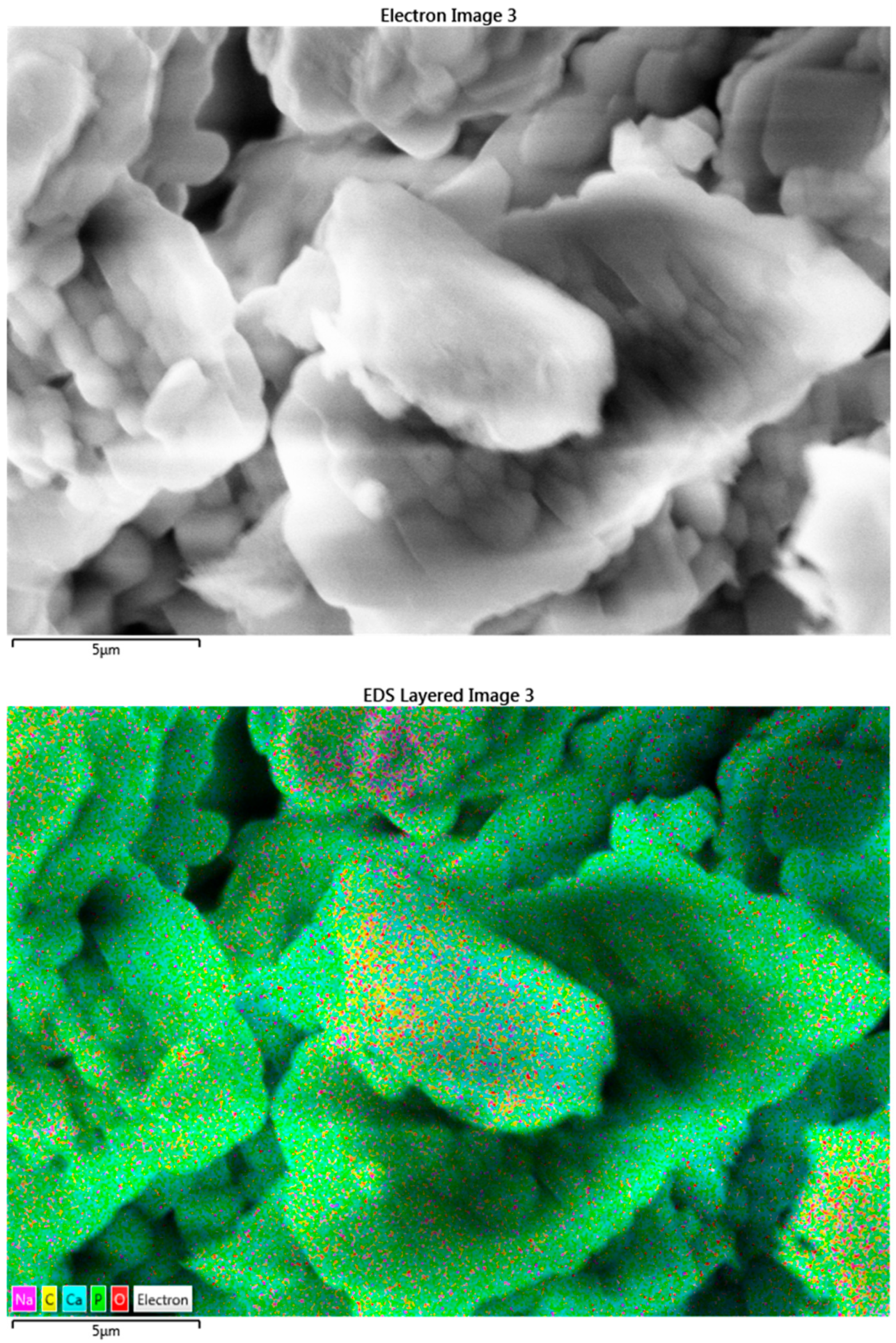Upcycling of Eggshell Waste into Calcium Phosphates for Use in Sustainable Biomedical Engineering Applications
Abstract
1. Introduction
2. Materials and Methods
3. Results and Discussion
4. Conclusions
Author Contributions
Funding
Data Availability Statement
Acknowledgments
Conflicts of Interest
References
- Waheed, M.; Yousaf, M.; Shehzad, A.; Inam-Ur-Raheem, M.; Khan, M.K.I.; Khan, M.R.; Ahmad, N.; Abdullah, R.; Aadil, M. Channelling eggshell waste to valuable and utilizable products: A comprehensive review. Trends Food Sci. Technol. 2020, 106, 78–90. [Google Scholar] [CrossRef]
- Mignardi, S.; Archilletti, L.; Medeghini, L.; De Vito, C. Valorization of eggshell Biowaste for Sustainable environmental Remediation. Sci. Rep. 2020, 10, 2436. [Google Scholar] [CrossRef] [PubMed]
- Vandeginste, V. Food waste eggshell valorization through development of new composites: A review. Sustain. Mater. Technol. 2021, 29, e00317. [Google Scholar] [CrossRef]
- Ray, S.; Barman, A.K.; Roy, P.K.; Singh, B.K. Chicken eggshell powder as dietary calcium source in chocolate cakes. Pharma Innov. J. 2017, 6, 1–4. [Google Scholar]
- Waheed, M.; Butt, M.S.; Shehzad, A.; Adzahan, N.M.; Shabbir, M.A.; Suleria, H.A.R.; Aadil, R.M. Eggshell calcium: A cheap alternative to expensive supplements. Trends Food Sci. Technol. 2019, 91, 219–230. [Google Scholar] [CrossRef]
- Syammaun, T.; Husaini; Abdulla; Isya, M.; Rachman, F. Assessing the performance of eggshell ash as a sustainable bitumen modifier. Transp. Eng. 2023, 13, 100196. [Google Scholar] [CrossRef]
- Meng, X.; Deng, D. Trash to Treasure: Waste Eggshells Used as Reactor and Template for Synthesis of Co9S8 Nanorod Arrays on Carbon Fibers for Energy Storage. Chem. Mater. 2016, 28, 3897–3904. [Google Scholar] [CrossRef]
- Quina, M.J.; Soares, M.A.R.; Ferreira, R.Q. Applications of industrial eggshell as a valuable anthropogenic resource. Resour. Conserv. Recycl. 2017, 123, 176–186. [Google Scholar] [CrossRef]
- Razak, A.; Isa, N.M.; Adzila, S. Synthesis of Calcium Phosphate Extracted from Eggshell Waste through Precipitation Method. Biointerface Res. Appl. Chem. 2021, 11, 15058–15067. [Google Scholar] [CrossRef]
- Kalbarczyk, M.; Szczes, A. Potential biomedical application of calcium phosphates obtained using eggshells as a biosource of calcium at different initial pH values. Ceram. Int. 2021, 47, 33687–33696. [Google Scholar] [CrossRef]
- Khana, S.R.; Alib, S.; Zahraa, G.; Jamila, S.; Janjua, M.R.S.A. Synthesis of monetite micro particles from egg shell waste and study of its environmental applications: Fuel additive and catalyst. Chem. Phys. Lett. 2020, 755, 137804. [Google Scholar] [CrossRef]
- Elliott, J.C. Calcium Phosphate Biomineral. Rev. Mineral. Geochem. 2002, 48, 427–453. [Google Scholar] [CrossRef]
- Correa, T.H.A.; Holanda, J.N.F. Calcium pyrophosphate powder derived from avian eggshell waste. Ceramica 2016, 62, 278–280. [Google Scholar] [CrossRef][Green Version]
- Dorozhkin, S.V.; Epple, M. Biological and Medical Significance of Calcium Phosphates. Angew. Chem. Int. Ed. 2002, 41, 3130–3146. [Google Scholar] [CrossRef]
- Hin, T.S. Engineering Materials for Biomedical Application; World Scientific Publishing Co., Pte. Ltd.: Singapore, 2004; Volume 1. [Google Scholar]
- Rheima, A.M.; Abdul-Rasool, A.A.; Al-Sharify, Z.T.; Zaidan, H.K.; Athair, D.M.; Mohammed, S.H.; Kianfar, E. Nano bioceramics: Properties, applications, hydroxyapatite, nanohydroxyapatite and drug delivery. Case Stud. Chem. Environ. Eng. 2024, 10, 100869. [Google Scholar] [CrossRef]
- Farag, M.M. Recent trends on biomaterials for tissue regeneration applications: Review. J. Mater. Sci. 2023, 58, 527–558. [Google Scholar] [CrossRef]
- Ajmal, S.; Hashmi, F.A.; Imran, I. Recent progress in development and applications of biomaterials. Mater. Today Proc. 2022, 62, 385–391. [Google Scholar] [CrossRef]
- Wang, X.; Wu, D.; Li, W.; Yan, L. Emerging biomaterials for reproductive medicine. Eng. Regen. 2021, 2, 230–245. [Google Scholar] [CrossRef]
- Qi, C.; Lin, J.; Fua, L.H.; Huang, P. Calcium-based biomaterials for diagnosis, treatment, and theranostics. Chem. Soc. Rev. 2018, 47, 357–403. [Google Scholar] [CrossRef]
- Epple, M. Review of potential health risks associated with nanoscopic calcium phosphate. Acta Biomater. 2018, 77, 1–14. [Google Scholar] [CrossRef]
- Fan, J.; Schiemer, T.; Steinberga, V.; Vaska, A.; Metlova, A.; Sizovs, A.; Locs, J.; Klavins, K. Exploring the Impact of Calcium Phosphate Biomaterials on Cellular Metabolism: A Metabolomics Study. Heliyon 2024, 10, e39753. [Google Scholar] [CrossRef] [PubMed]
- Toloue, B.; Mohammadalizadeh, Z.; Mukherjee, S.; Karbasi, S. Incorporation of inorganic bioceramics into electrospun scaffolds for tissue engineering applications: A review. Ceram. Int. 2022, 48, 8803–8837. [Google Scholar] [CrossRef]
- Zhoua, H.; Yanga, L.; Gbureckc, U.; Bhaduri, S.B.; Sikder, P. Monetite, an important calcium phosphate compound—Its synthesis, properties and applications in orthopedics. Acta Biomater. 2021, 127, 41–55. [Google Scholar] [CrossRef] [PubMed]
- Lu, J.; Yu, H.; Chen, C. Biological properties of calcium phosphate biomaterials for bone repair: A review. RSC Adv. 2018, 8, 2015–2033. [Google Scholar] [CrossRef]
- Habraken, W.; Habibovic, P.; Epple, M.; Bohner, M. Calcium phosphates in biomedical applications: Materials for the future? Mater. Today 2016, 19, 69–87. [Google Scholar] [CrossRef]
- Tolmacheva, N.; Bhattacharyya, A.; Noh, I. Calcium Phosphate Biomaterials for 3D Bioprinting in Bone Tissue Engineering. Biomimetics 2024, 9, 95. [Google Scholar] [CrossRef]
- Saghatchi, H.; Ansari, R.; Mousavi, H.Z. Highly efficient adsorptive removal of uranyl ions from aqueous solutions using dicalcium phosphate nanoparticles as a superabsorbent. Nucl. Eng. Technol. 2018, 50, 1112–1119. [Google Scholar] [CrossRef]
- Dutta, M.A.; Hanifa, M.A.; Nadeema, F.; Bhatti, H.N. A review of advances in engineered composite materials popular for wastewater treatment. J. Environ. Chem. Eng. 2020, 8, 104073. [Google Scholar] [CrossRef]
- Ahmed, M.K.; Afifi, M.; Mansour, S.F.; Ibrahium, H.A.; Aldulmani, S.A.A.; Awwad, N.S. Morphological behaviors of brushite/vivianite nanocomposites and their potency for Se(IV) and Cd(II) removal from aqueous solutions. Mater. Chem. Phys. 2021, 259, 124057. [Google Scholar] [CrossRef]
- Wang, Q.; Zuo, W.; Tian, Y.; Kong, L.; Cai, G.; Zhang, H.; Li, L.; Zhang, J. Flexible brushite/nanofibrillated cellulose aerogels for efficient and selective removal of copper(II). Chem. Eng. J. 2022, 450, 138262. [Google Scholar] [CrossRef]
- Fihri, A.; Len, C.; Varma, R.S.; Solhy, A. Hydroxyapatite: A review of syntheses, structure and applications in heterogeneous catalysis. Coord. Chem. Rev. 2017, 48, 347–376. [Google Scholar] [CrossRef]
- Guo, X.; Liu, B.; Gao, X.; He, F.; Ma, Q.; Fan, S.; Zhao, T.; Tian, J.; Reubroycharoen, P.; Zhang, J. Improved olefin selectivity during CO hydrogenation on hydrophilic Fe/HAP catalysts. Catal. Today 2023, 410, 193–204. [Google Scholar] [CrossRef]
- Phan, T.S.; Sane, A.R.; de Vasconcelos, B.R.; Nzihou, A.; Sharrock, P.; Grouset, D.; Minh, D.P. Hydroxyapatite supported bimetallic cobalt and nickel catalysts for syngas production from dry reforming of methane. Appl. Catal. B Environ. 2018, 224, 310–321. [Google Scholar] [CrossRef]
- Madhu, D.; Sharma, Y.C. Synthesis of a reusable novel catalyst (-tricalcium phosphate) for biodiesel production from a common Indian tribal feedstock. Res.-Effic. Technol. 2017, 3, 144–157. [Google Scholar] [CrossRef]
- Bitire, S.O.; Jen, T.C.; Belaid, M. Synthesis of beta-tricalcium phosphate catalyst from Herring fishbone for the transesterification of parsley seed oil. Environ. Technol. 2021, 43, 3175–3187. [Google Scholar] [CrossRef]
- Sharma, P.; Rohilla, D.; Chaudhary, S.; Kumar, R.; Singh, A.N. Nanosorbent of hydroxyapatite for atrazine: A new approach for combating agricultural runoffs. Sci. Total Environ. 2019, 653, 264–273. [Google Scholar] [CrossRef]
- Xionga, L.; Wang, P.; Kopittke, P.M. Tailoring hydroxyapatite nanoparticles to increase their efficiency as phosphorus fertilisers in soils. Geoderma 2018, 323, 116–125. [Google Scholar] [CrossRef]
- Muljani, S. Synthesis of Tricalcium Phosphate from Eggshells with Precipitation Method. J. Phys. Conf. Ser. 2020, 1569, 042057. [Google Scholar] [CrossRef]
- Gomes, L.C.; Di Lello, B.C.; Campos, J.B.; Sampaio, M. Synthesis and Characterization of calcium phosphates produced from chicken eggshell. Ceramica 2012, 58, 448–452. [Google Scholar] [CrossRef]
- Bartter, J.; Diffey, H.; Yeung, Y.H.; O’Leary, F.; Häsler, B.; Maulaga, W.; Alders, R. Use of chicken eggshell to improve dietary calcium intake in rural sub-Saharan Africa. Matern. Child Nutr. 2018, 14 (Suppl. 3), e12649. [Google Scholar] [CrossRef]
- Pountouenchi, A.; Ndzana, E.J.A.; Mountapbeme, I.C.; Njuhou, S.; Njoya, A.; Fagel, N.; Pilate, P.; Njoya, D.; Mbey, J.A. Porous refractory ceramics using agrowastes and some kaolinitic clays. Open Ceram. 2024, 18, 100568. [Google Scholar] [CrossRef]
- Aqib, M.; Alomar, M.; Anwar, A.; Naseem, K.; Javaid, A.; Intisar, A.; Khan, S.; Ajaz, H.; Khan, I.H. Synthesis, characterization and antimicrobial analysis of metal-doped (Zn2+ and Ag+) brushite powder for bone regeneration. Mater. Chem. Phys. 2024, 320, 129460. [Google Scholar] [CrossRef]
- Rödel, M.; Teßmar, J.; Groll, J.; Gbureck, U. Dual setting brushite—Gelatin cement with increased ductility and sustained drug release. J. Biomater. Appl. 2022, 36, 1882–1898. [Google Scholar] [CrossRef] [PubMed]
- Saleh, A.T.; Ling, L.S.; Hussain, R. Injectable magnesium-doped brushite cement for controlled drug release application. J. Mater. Sci. 2016, 51, 7427–7439. [Google Scholar] [CrossRef]
- Kim, Y.; Lee, S.Y.; Roh, Y.; Lee, J.; Kim, J.; Lee, Y.; Bang, J.; Lee, Y.J. Optimizing Calcium Phosphates by the Control of pH and Temperature via Wet Precipitation. J. Nanosci. Nanotechnol. 2015, 15, 10008–10016. [Google Scholar] [CrossRef]







Disclaimer/Publisher’s Note: The statements, opinions and data contained in all publications are solely those of the individual author(s) and contributor(s) and not of MDPI and/or the editor(s). MDPI and/or the editor(s) disclaim responsibility for any injury to people or property resulting from any ideas, methods, instructions or products referred to in the content. |
© 2024 by the authors. Licensee MDPI, Basel, Switzerland. This article is an open access article distributed under the terms and conditions of the Creative Commons Attribution (CC BY) license (https://creativecommons.org/licenses/by/4.0/).
Share and Cite
Pagonis, N.; Flegkas, D.; Itziou, A.; Kountouras, K.; Stimoniaris, A.; Samaras, P.; Karayannis, V. Upcycling of Eggshell Waste into Calcium Phosphates for Use in Sustainable Biomedical Engineering Applications. Eng 2024, 5, 3540-3550. https://doi.org/10.3390/eng5040184
Pagonis N, Flegkas D, Itziou A, Kountouras K, Stimoniaris A, Samaras P, Karayannis V. Upcycling of Eggshell Waste into Calcium Phosphates for Use in Sustainable Biomedical Engineering Applications. Eng. 2024; 5(4):3540-3550. https://doi.org/10.3390/eng5040184
Chicago/Turabian StylePagonis, Nikolaos, Dimitrios Flegkas, Aikaterini Itziou, Konstantinos Kountouras, Adam Stimoniaris, Petros Samaras, and Vayos Karayannis. 2024. "Upcycling of Eggshell Waste into Calcium Phosphates for Use in Sustainable Biomedical Engineering Applications" Eng 5, no. 4: 3540-3550. https://doi.org/10.3390/eng5040184
APA StylePagonis, N., Flegkas, D., Itziou, A., Kountouras, K., Stimoniaris, A., Samaras, P., & Karayannis, V. (2024). Upcycling of Eggshell Waste into Calcium Phosphates for Use in Sustainable Biomedical Engineering Applications. Eng, 5(4), 3540-3550. https://doi.org/10.3390/eng5040184







